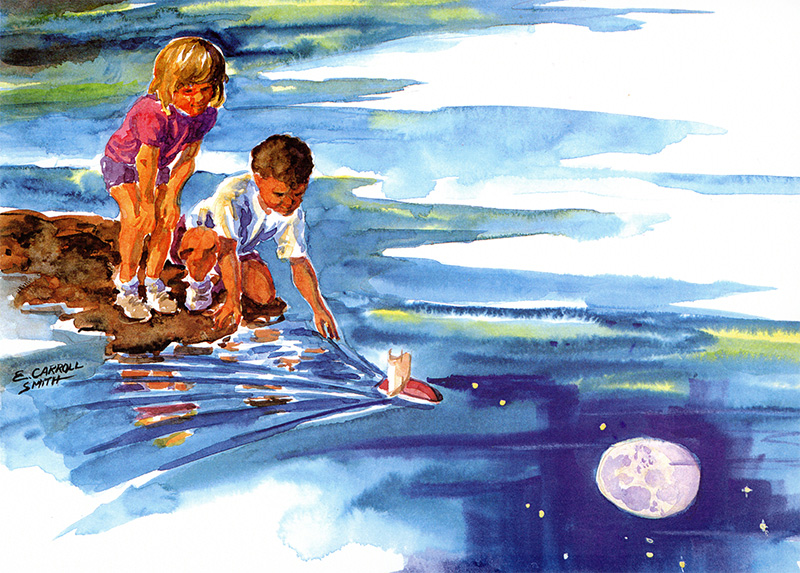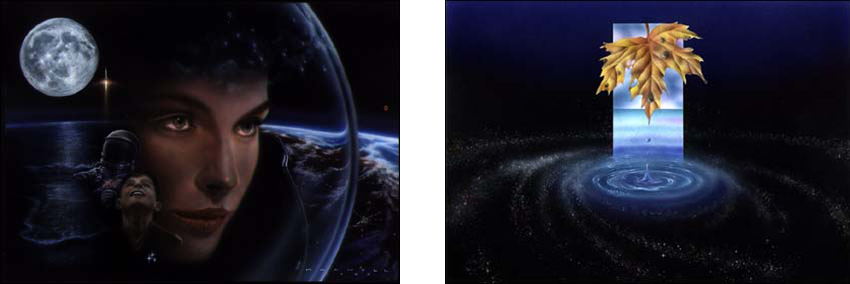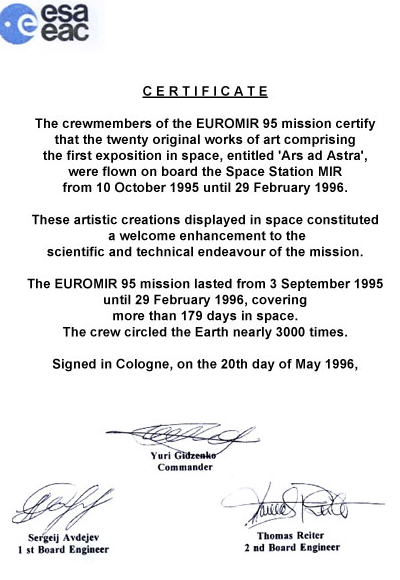This text by Arthur Woods was first published on the Astronomers Without Borders website as the AstroArtist for the Month of April, 2016
AstroArtist of the Month – Arthur Woods (Part 3b of 4)
The Orbiting Unification Ring Satellite and the OUR-Space Peace Sculpture projects were the beginnings of the OURS Foundation’s “private space program” which began to unfold and develop in other and sometimes parallel directions. Below is the history and details of the spaceflight of the Ars Ad Astra: The 1st Art Exhibition in Earth Orbit that was realized on the Mir space station.
Ars Ad Astra: The 1st Art Exhibition in Earth Orbit
Mir Space Station 1995
Involving other artists in space has always been a goal of the OURS Foundation. In its negotiations with the Russian space company NPO Energia in 1990, the idea to organize an art exhibition on the Mir space station as part of the International Space Year (ISY) was introduced and discussed. While an initial agreement was reached, subsequent negotiations concerning the division of responsibilities continued throughout 1991 to the point where no satisfactory arrangement could be reached in time for the 1992 ISY. After the successful spaceflight of the Cosmic Dancer in 1993, the idea was re-introduced.
We then learned about the Euromir94 and Euromir95 missions being planned by the European Space Agency (ESA). As the OURS Foundation was a cultural and astronautical organization based in Switzerland, and Switzerland was a member of ESA, in July 1994, a proposal was submitted to ESA for a “cultural experiment” to be conducted in the framework of the Euromir95 mission. As proposed, the content of the Ars ad Astra payload would consist of up to 100 A4 (21 x 30 cm) artworks and a portable Kodak Photo CD player weighing a total of 3 kg. After consultation with the office responsible for the Euromir95 mission concerning the technical feasibility of our proposal, Mr. Jörg Feustel-Büechl, ESA Director for Manned Spaceflight & Microgravity, answered on September 2, 1994 informing the OURS Foundation that ESA was prepared to accept our proposal.
In his letter he stated:
“We also feel that the purpose of your project which is to make people more aware of the value and importance of space activities is a good one and merits support.”
However as implementation activities commenced, the OURS Foundation was informed that ESA had only agreed to fly our “Ars ad Astra experiment” on the condition that this project would have no major financial impact for ESA. They pointed out that our experiment, as proposed, would add approximately 100,000 Accounting Units (AU) in additional costs to the Euromir95 budget. ESA officials indicated that, unless the Russian managers of the Mir station were willing to accept this additional weight at no charge, ESA could only agree to fly the electronic aspect of the project if this could conform to the suggestions made by the mission office, which was to replace the portable Photo-CD player concept by copying the images to a hard drive for the onboard ESA computer. This approach would result in essentially no additional weight or cost. In response to our request for a contribution from ESA to the project’s communication budget, we were informed that “in face of mounting pressure by member delegations to find additional savings in the 1995 budget”, ESA would be unable to supply any additional financial support and suggested that the OURS Foundation find sponsors to assist with its communications activities.
At this point Ars ad Astra consisted of the possibility of just sending digitized art into space. This was not the art exhibition that we had originally proposed. Aware of the importance and value attached to the tangible quality of original art, the fact that up until now very few art works had ever been flown in space and that both the interest of the artists, the public and the media could only be stimulated and maintained if the original artworks were flown into space, the OURS Foundation insisted that for this experiment to effectively address its stated objectives, a quantity of original artworks had to be included in the payload.
Whereupon several months of negotiations ensued between the OURS Foundation and ESA with the result being that on February 14, 1995 we were given the approval to fly a minimum of 13 original artworks and the hard disk to the Mir station, and that all but one of the artworks would be returned to Earth. Our total payload was not to exceed 1 kg. Eventually, the Ars ad Astra payload was integrated into the mass budget of 10 kg that was allotted to ESA’s Public Relations department for the Euromir95 mission. As such, our experiment did not represent a significant additional cost to the agency.
With the final confirmation from ESA, an immediate effort was initiated to implement the experiment by reaching out to artists and, at the same time, looking for sponsors to assist the communications aspects. Before the ESA confirmation it was neither possible to solicit artists nor to contact potential sponsors. As the anticipated launch date at that time was set for the end of August, 1995, this left approximately five months to conduct an international competition, to jury and select the artworks, to prepare the communication materials for the media, to document the artworks and to deliver them in the prescribed manner to the mission officials in time for their integration into the Euromir95 payload.
We were able to recruit two Swiss firms as sponsors – the watch company OMEGA S.A. and Alois Diethelm A.G., the manufacturer of LASCAUX artists’ materials to assist our communication efforts and to donate prizes to the artists whose works were selected for spaceflight. With the final go-ahead we assumed that, even though ESA could not contribute financially to our communications effort, as they had agreed to include Ars ad Astra in the Euromir95 mission, they would use whatever established means available to help us in our efforts to reach out to artists, especially in Europe. A “Call For Art” and an initial “Press Release” were prepared and submitted to ESA for their approval. To our surprise, we were immediately informed by the ESA communications office: that our cultural experiment could not be referred to as an “experiment” as this would confuse the perception of their process of selecting experiments, that our project could not be called “official” because that term was reserved for experiments, and furthermore, the use of the ESA logo or the Euromir95 logo on any of our own announcements was prohibited, and, as their Euromir95 communications effort was being prepared according to plan, they would not, or could not mention our project in any of their official public communications at that point.
Working under these restraints, and as Internet in 1995 was still in its early stages, the “Call for Art” went mainly to space organizations, art organizations and to space and art publications mostly via normal mailing and by advertisements. The theme chosen for the art exhibition was “Space & Humanity” and artists were instructed to create A4 sized artworks on paper (21 x 29.7cm) using “space qualified” materials such as the Lascaux acrylic paints which were previously tested and certified in conjunction with the 1993 spaceflight of the Cosmic Dancer sculpture on Mir. A sample set of Lascaux paints were sent to each registered artist. As a result, by June 31, 1995, 82 artists from 14 countries submitted a total of 171 artworks for consideration.
On July 7, 1995 a jury consisting of: space artist Ludek Pesek, Dr. Roger Malina, astrophysicist and editor of Leonardo – the Journal of the Society for Arts, Science and Technology , Dr. Karl Knott, the ESA official responsible for the technical implementation of the Ars Ad Astra project at ESTEC, Mr. Pierre-Dominique Cochard, Press Relations manager for OMEGA S.A., Dr. Marco C. Bernasconi, vice-president of the OURS Foundation and myself, met in Switzerland and evaluated the diverse selection of artworks interpreting the “Space & Humanity” theme.
The submitted artworks contained all types of artistic expression ranging from very abstract to very representative. Many of the artworks had significant symbolic elements. There was no attempt at geographical distribution and it was agreed that only one artwork from each participating artist would be selected. In the end, 20 artworks were chosen by the jury. As the artists had diligently followed the instructions, the total weight for the 20 artworks was only 246 grams. As this was substantially under our allotted weight budget, it was then proposed to ESA to accept all 20 of the selected artworks and they approved.
One artwork from each of the following artists was selected: Alessandro Bartolozzi (I), Peter Binz (CH), Werner Beyeler (CH) , Michael Böhme (D), Marcy Burt Butz (CH), Michael Carroll (USA), Chris Couvee (NL), Karl Draeger (D), Peter Eickmeyer (D), Marilynn Flynn (UAE), Rudolf Halaczinsky (D), Rudolf Hanke (D), Sarah Kernaghan (IRL), Mark Maxwell (USA), Edward Mendelsohn (GB), Elizabeth Smith (USA), Ruth Trapane (USA), Andrea Thüler (CH), Claudine Varesi (MEX) and Amy Zofko (USA).
The artworks were photographed and documented. A Photo-CD including one artwork from each submitting artist was produced for the electronic archive. This and the 20 selected artworks were then delivered to ESA mission officials at ESTEC at the end of July. The works were subsequently delivered to the Russian space officials who were responsible for their packaging and integration on the Soyuz TM-71 capsule. The electronic works were copied onto the mission hard disk so that these works would be displayed on the Payload and Crew support computer. On August 25, 1995, prior to the launch ESA issued Press Release 31-95 which mentioned the Ars ad Astra exhibition and the upcoming downlink scheduled for November.
On September 3, 1995, the Ars ad Astra exhibition accompanied ESA astronaut Thomas Reiter and his Russian cosmonaut colleagues Sergei Avdeev and Yuri Gudzenko on their successful launch to the Mir space station. This crew would serve as the final jury of Ars ad Astra and they were instructed to pick one of the 20 artworks to stay on the Mir station. The announcement of the winner was scheduled to take place during a live link-up with the Mir.

Euromir95 mission patch and crew members.
On November 30, 1995 a live video link-up was arranged between the Mir space station and the Euro Space Center – a space camp located near Transinne. Belgium. As this was one of ESA’s four announced link-ups to be carried live by the media, approximately 100 journalists from various media covered the event. 13 of the 20 artists whose works were selected for the spaceflight were in attendance including several who had travelled from overseas (USA and Mexico). As the Mir station passed over Belgium, the link-up began in the late afternoon and lasted approximately 20 minutes. Cosmonaut Thomas Reiter and his two Russian colleagues described the pleasure they had to view the many artworks as well as the difficulty they had to choose one of them as the winning artwork.

The 1st Art Exhibition in Earth Orbit on Mir Mir station / Transinne, Belgium live link-up.
Thomas Reiter made the following comments during the live link-up:
“It was quite a difficult task for us to select a favorite picture out of these because we liked them all. We took the task very seriously, in fact it took us more than a week. One evening we took 10 out of the 20, on the next evening we dropped three of the ten, so just seven were left. …….. The winner is the picture from Ms Carroll Smith …”When Dreams are Born” ….. as second place we choose the picture from Mark Maxwell called “Promise” and third place is a picture called “Unforgettable Home” by Alessandro Bartolozzi …..we like to thank all the artists………”
“…..and let me tell you that there are many things here on board which keep us alive, of course technical systems which produce oxygen to breathe, water to drink which clean the air from carbon dioxide, food and all these things which help to keep us alive, life support systems. But I can tell you that this kind of thing (he holds up a picture) are a part of what is necessary to keep us alive, to keep the memory to the Earth, to our families, to our friends, to the nature.”
“So we thank you all very much for these beautiful pictures, and for those who have not been selected ……. we can assure you that we like all of your pictures. Maybe it was a little unfair to force us to do a selection, so, thank you very much.”

When Dreams are Born, Elizabeth Carroll Smith

Promise, Mark Maxwell Unforgettable Home, Allesandro Bartolozzi
The winning artist, Elizabeth Carroll Smith, received a specially engraved OMEGA Speedmaster Professional Chronograph that was previously flown on the Mir station. This prize had a commercial value of $10,000. All the 20 artists received a selection of “space qualified” artists’ paints donated by the Swiss Lascaux paint company. On February 29, 1996, after having spent 179 days in orbit, Thomas Reiter returned to Earth bringing with him the remaining 19 artworks. The winning artwork and the electronic archive remained on Mir space station for the enjoyment of future crews.

ESA Certificate
An international exhibition tour began at the 46th International Astronautical (IAF) Congress in Oslo, Norway – October 2-6, 1995. As the original works were still on the Mir station during this Congress, only high quality reproductions were on display. Other exhibitions took place at ESTEC in the Netherlands, the Swiss Transportation Museum in Lucerne, Switzerland in the summer of 1997, and at the 47th IAF Congress held in Turin, Italy in October 1997, and on the Internet.
Ars ad Astra: The 1st Art Exhibition in Earth Orbit was indeed a “cultural experiment” and like many experiments it yielded expected and unexpected results. Originally designed as an experiment to stimulate the public’s perception about space through a novel artistic intervention, it became more of an experiment about the process of adding a cultural dimension to the world’s space program.
This text by Arthur Woods was first published on the Astronomers Without Borders website as the AstroArtist for the Month of April, 2016
AstroArtist of the Month – Arthur Woods (Part 3b of 4)
